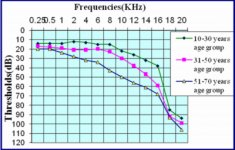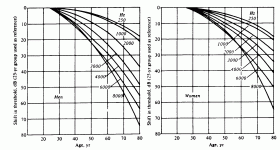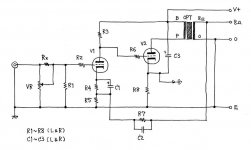I measured my 125ESE ( 8 years abused at the time ) at:
-3 db 55 Hz
-2 db 70 Hz
-1 db 100 Hz
0 db 1 KHz
0 db 6 KHz
-0.5 db 10 Khz
-0.8 dB 15 KHz
-1.5 db 20 KHz
with 801A at 1 watt output, 10K plate load, 8 ohm resistive load.
Mine still met spec, after eight years of abuse. Unless your transformers are bad, you should be hearing lots of highs.
Win W5JAG
-3 db 55 Hz
-2 db 70 Hz
-1 db 100 Hz
0 db 1 KHz
0 db 6 KHz
-0.5 db 10 Khz
-0.8 dB 15 KHz
-1.5 db 20 KHz
with 801A at 1 watt output, 10K plate load, 8 ohm resistive load.
Mine still met spec, after eight years of abuse. Unless your transformers are bad, you should be hearing lots of highs.
Win W5JAG
Thanks W5jag,
I have a pair of those 125ESE, so now I know what to expect from them.
So it sounds like John007's problem may be either the speaker, or something listed in post #20.
Schematic time; picture of the inside of the amp time.
I have a pair of those 125ESE, so now I know what to expect from them.
So it sounds like John007's problem may be either the speaker, or something listed in post #20.
Schematic time; picture of the inside of the amp time.
Last edited:
Attachments
YouTube
Mini Watters project
OPT 7k:8, does gNFB or lNFB matter?
YouTube
This one is OTL, you know which sounds better.
Sound depends a lot also on the recording, direct recording is better than through the air. I am surprised they sound like big amp.
Mini Watters project
OPT 7k:8, does gNFB or lNFB matter?
YouTube
This one is OTL, you know which sounds better.
Sound depends a lot also on the recording, direct recording is better than through the air. I am surprised they sound like big amp.
Attachments
It could be the front end, tone stack of the amplifier and nothing to do with the transformer. Or it could be the coupling between stages. To find the fault you really need to sweep each stage etc.
Lastly even with an OPT of limited BW of up to 15khz ish high's should be well audible; anything in music content over 10khz for most of us is irellevant.
Andy.
Lastly even with an OPT of limited BW of up to 15khz ish high's should be well audible; anything in music content over 10khz for most of us is irellevant.
Andy.
OTL amp sounds little better in high frequency than my, but i have better bass with hammond. 6n6 has not problem with big speakers, the amp is strong like 10watt transistor amplifier but much better sound.
I measured my 125ESE ( 8 years abused at the time ) at:
-3 db 55 Hz
-2 db 70 Hz
-1 db 100 Hz
0 db 1 KHz
0 db 6 KHz
-0.5 db 10 Khz
-0.8 dB 15 KHz
-1.5 db 20 KHz
with 801A at 1 watt output, 10K plate load, 8 ohm resistive load.
Mine still met spec, after eight years of abuse. Unless your transformers are bad, you should be hearing lots of highs.
Win W5JAG
I agree with this gentleman. I have a 12B4/6au6 triode SE amplifier with 125ese transformers. Your thread had me check them with the signal generator and scope. My results are the same as above. I have three possibilites for your consideration. 1.) Check your hearing. 2.) change your speakers. 3.) Change your amplifier circuit.
My 6AU6/12B4 is not lacking in response with my garage Altec model 9 speakers. My hearing being 65 now isn't what it used to be. I respectfully suggest that you check your hearing first followed by posting the schematic of your amplifier and the particular speakers your using along with their specifications.
I use 2.5k load impedance, black and white line sounds best, speaker is Jensen p12s. Edcor has two series xse and gsxe, i don´t know what to buy, 25 watt xse or 15 watt gsxe. Load impedance 2.5k or 3K? I don´t use tweeter so high frequency is little lost. I don´t hear cymbals.
You complain about the transformers yet in this post it sounds like your trying to use a speaker that isn't suited to your needs. As I pointed out and others have pointed out the problem isn't the transformers because they check well. Content at 15K? Well, I wouldn't count on it in most music here in the states and surely not on the radio. Lack of cymbals ? I would start pointing my fingers at your speakers.
You complain about the transformers yet in this post it sounds like your trying to use a speaker that isn't suited to your needs. ........ I would start pointing my fingers at your speakers.
Here's some info on the Jensen P12S speaker:
Speaker Gurus - Jensen P12S? | Telecaster Guitar Forum
Low-power guitar and PA speakers with 'breakup' (distortion) at lower volumes - something guitar players like.
I do know that hi-fi speakers don't sound very good when used for guitar amps.
Is the converse also true?
One characteristic of guitar speakers is that they are usually quite efficient, so that would be a plus for a system with a low power amp.
It's so simple to find cheap used hifi speakers in most places (in N America anyway) that it would be easy to do some comparison tests, to eliminate the speakers as the 'problem'. They wouldn't be as loud, but the highs might be more obvious.
Or, get one of those $10 signal generators from eBay, or download some test tones, or......
I've built RH amps using smaller and lower quality OTs than those Hammonds, and they had lots of treble (and bass).
Let us help you by helping us. Plug in a known HiFi speaker that plays up to about 20kHz and tell us if the high-end sounds any different. My money is on the Jensen speaker. It's for guitar, so expect nothing of values over 6kHz.
All of the 1W/1M frequency response graphs for the jensen p12 series instrument speakers that I found have peaks of approximately 109db at 2khz and drop off to less than 80db by 10khz.
Comparing Frequency Response Charts | Jensen Loudspeakers
Steve
Comparing Frequency Response Charts | Jensen Loudspeakers
Steve
Exactly. As expected from a speaker famous for guitar applications. Neither "wide range" of "high fidelity".
There is a solution, Baxandall type tone control:
AC/DC 12V 24V Assembled LM1036 Tone Board Treble Bass Balance Volume Control M | eBay
AC/DC 12V 24V Assembled LM1036 Tone Board Treble Bass Balance Volume Control M | eBay
A Bax won't put the sizzzz in a guitar speaker, because of the STEEP roll-off explained above.
This particular model is not "guitar" but "extended range". Even so, a deep-cone Twelve can't get past 8KHz. This was wide-range once upon a time, but not enough for modern recording tastes. Agree to try a "real" hi-fi speaker before blaming a transfomer.
This particular model is not "guitar" but "extended range". Even so, a deep-cone Twelve can't get past 8KHz. This was wide-range once upon a time, but not enough for modern recording tastes. Agree to try a "real" hi-fi speaker before blaming a transfomer.
The 6N6Pi should have a plate resistance, rp, of approximately 1,800 Ohms. <snip>
Isn't 1800 ohms the RP for a single triode? If you read the description of the video that the OP linked, it says that both halves of the 6N6P triodes are in parallel. And yes, the schematic would be nice 😀
Tjj226,
A single plate resistance of 1,800 Ohms. Two parallel plate resistance of 900 Ohms (But usually only if you individually bias the tubes; either combined fixed bias or combined self bias often will not give that good of a result). Look for my posts, and some of my recent responses to posts, on this forum about Parallel Tubes, to get the best results.
A single plate resistance of 1,800 Ohms. Two parallel plate resistance of 900 Ohms (But usually only if you individually bias the tubes; either combined fixed bias or combined self bias often will not give that good of a result). Look for my posts, and some of my recent responses to posts, on this forum about Parallel Tubes, to get the best results.
I compare my tubelab SSE amps,one with the large Edcors and one with the 125 ESE Hammonds and there is not that much difference, Both amps sound very nice.
9050LX,
What speakers are you using with your SSE amps? Just curious. I'll get around to building an SSE some fine day.
Thanks, Steve
What speakers are you using with your SSE amps? Just curious. I'll get around to building an SSE some fine day.
Thanks, Steve
- Home
- Amplifiers
- Tubes / Valves
- Hammond 125ese upgrade, need help.


